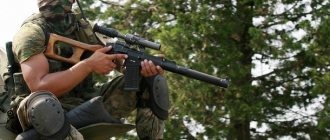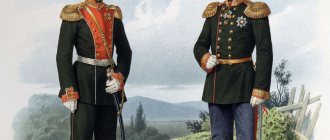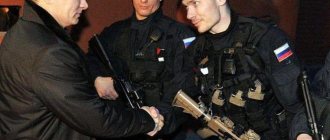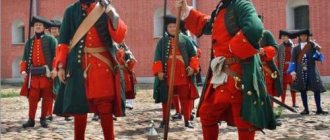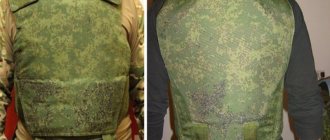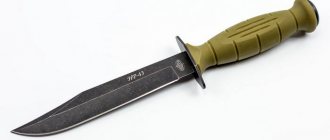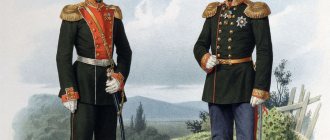History and types of caps
Historically, the cap was a development of the shako, whose awkward high shape in the uniforms of European armies until the mid-19th century was gradually reduced to the modern cap shape.
Cap in the Russian army
In the armed forces of the Russian Empire, soldiers' caps belonged to a special category of clothing items for troops - uniform items. The cap was sold in the form of materials and always for a certain period. Made in regimental workshops.
In Russia in the 19th century, on uniform caps on the bands there was a cockade and/or emblem of the type of weapon (badge), engineering specialty, and so on. An additional sign could be placed on the crown. In summer, a white cover was put on the cap.
USSR Armed Forces
In the USSR Armed Forces since 1969, the cap for officers consisted of:
- the bottom, oval in shape (the cap for officers of the Navy was additionally provided with a removable, white cover);
- crown;
- band;
- edging along the upper edge of the band and along the edge of the bottom;
- ribbons (black, for caps for officers of the Navy);
- visor (in some cases there was an ornament on it);
- braided cord (on the field cap there was a chin strap instead);
- emblems (sewing) (to whom it is due);
- cockades;
- uniform buttons (two).
Peak cap of foreign countries
The cap of the US Navy is replaced by a white Panama hat, without identification marks and the traditional Russian Navy ribbon. The American cap has not undergone any changes since the Second World War.
Panama hats for US Navy personnel.
This is a casual headdress that replaced the unpopular Donald Duck cap, so named because of its resemblance to the headdress of the Disney cartoon character.
In Great Britain, the lower ranks of the Royal Navy were equipped with visors, on which the inscription of the name of the ship was embroidered, but this was before the Second World War.
After England entered the war, the name of the ship on the band of the cap was replaced by an inscription of three letters “HMS”, which stood for “His Majesty's Ship” without the name of the ship
This was due to simple precautions during the war
Peak cap of the Royal British Navy.
The German Navy did the same, removing the ship's name from the ribbons. Privates in the navy wore blue caps, which gradually fell out of use and remained part of the dress uniform, which was distinguished by the presence of a white cover, on top of which a black, white and red cockade was attached, and the state emblem - an eagle - was sewn above.
Main parts
The main elements and accessories of the cap (using the example of the cap of the Ministry of Railways of the USSR/Russia):
- Cockade with an emblem and an emblem (this cap is called a “technical badge”).
- Welt is a strap (on field caps, for example, it is also called a “chin strap”). In this case, the welt is a twisted filigree cord.
- Visor.
- Kant -
- band -
- tulya -
Caps often have reinforcing inserts - a steel hoop to maintain the shape of the crown and give it a bend (if necessary), fabric (cotton) rollers to fill the crown, as well as band seals (made of cardboard) to maintain its shape.
Certain types of caps may have replaceable covers (for example, a summer white cover for naval caps).
First steps
Different types of troops could be recognized by the color of their uniforms:
- black – tankers;
- green – infantry;
- light green – mountain arrows.
Headdresses, which varied both in shape and in distinctive stripes, also played an important role. The first prototype of the uniform was created during the November Revolution. Then the rebel troops equipped themselves with what was left in the “bins” from the First World War. Standardizing the uniform, the government provided employees with headdresses based on the caps used in the army of the Austrian Empire.
The first updated prototype was released in 1925. After that, with a difference of 3-4 years, the developers released new samples of both uniforms and hats.
In total, the High Command endorsed five types of caps by the end of 1943. The caps of SS officers were practically no different from the hats of soldiers of lower rank. Only an experienced person could tell at first glance which military man was in front of him and in what rank.
Gallery
- Alexander II of Russia by Monogrammist VG (1888, Hermitage) detail.jpg
Alexander II in a general's uniform cap (1865).
- PortretOttovonBismarck.jpg
Colonel General with the rank of Field Marshal O. von Bismarck.
- A.M.Kovanko.JPG
Colonel A.M. Kovanko, St. Petersburg, 1904.
- Zhukov1916.jpg
Non-commissioned officer Georgy Zhukov, 1916.
- PavelKup2.jpg
Pavel Emelyanovich Kupriyanov
- Marshal Sergey F. Akhromeyev in 1988.JPEG
Marshal of the Soviet Union S.F. Akhromeev.
- Yedidya Yaari.jpg
Israeli Navy officer.
- Nathan Twining 02.jpg
General N. Twining in an American officer's uniform cap.
Marks of Excellence
With the advent of caps, the question arose about the insignia that was applied to caps and caps: a skull, an eagle, a swastika, and colored piping. All of them helped determine belonging to infantry, tank, assault or special forces.
Every headdress had a skull emblem: sometimes in the form of a patch, sometimes in the form of metal buttons. If other signs could be transferred to the left side of the headdress, then the skull was always on the cockade.
Army photos on Shutterstock: Army and military photos.
So why were there skulls on SS caps?
The skull, or "Adam's head", has been used in army insignia since the Middle Ages. In this way, the military designated special units that were of high value to the command as combat units.
The skull in the German army dates back to the time of the volunteer corps formed to fight the German communists. A little later, already during the spread of the doctrine of fascism throughout Europe, the skull became the distinctive sign of the SS troops subordinate to Hitler. The sign itself symbolized victory over death.
The German SS cap became the standard for many uniforms thereafter. The headdresses of the police of France, Italy, as well as various military units are sewn on the basis of German-style caps from the Second World War.
Excerpt characterizing Cap
“I would see you off, yes, by God,” here (the doctor pointed to his throat) I gallop to the corps commander. After all, how is it with us?.. You know, Count, tomorrow there is a battle: for a hundred thousand troops, a small number of twenty thousand wounded must be counted; but we have neither stretchers, nor beds, nor paramedics, nor doctors for six thousand. There are ten thousand carts, but other things are needed; do as you wish. That strange thought that from among those thousands of people alive, healthy, young and old, who looked at his hat with cheerful surprise, there were probably twenty thousand doomed to wounds and death (perhaps the same ones he saw), – Pierre was amazed. They might die tomorrow, why do they think about anything other than death? And suddenly, through some secret connection of thoughts, he vividly imagined the descent from Mozhaisk Mountain, carts with the wounded, the ringing of bells, the slanting rays of the sun and the song of the cavalrymen. “Cavalrymen go to battle and meet the wounded, and do not think for a minute about what awaits them, but walk past and wink at the wounded. And out of all these, twenty thousand are doomed to death, and they are surprised at my hat! Strange!" - thought Pierre, heading further to Tatarinova. At the landowner's house, on the left side of the road, there were carriages, vans, crowds of orderlies and sentries. The brightest stood here. But at the time Pierre arrived, he was not there, and almost no one from the staff was there. Everyone was at the prayer service. Pierre drove forward to Gorki. Having driven up the mountain and into a small street in the village, Pierre saw for the first time militia men with crosses on their hats and in white shirts, who were loudly talking and laughing, animated and sweaty, working something to the right of the road, on a huge mound overgrown with grass. . Some of them were digging a mountain with shovels, others were transporting earth on planks in wheelbarrows, and others stood doing nothing. Two officers stood on the mound, ordering them. Seeing these men, obviously still amused by their new, military situation, Pierre again remembered the wounded soldiers in Mozhaisk, and it became clear to him what the soldier wanted to express when he said that they wanted to attack the whole people. The sight of these bearded men working on the battlefield with their strange clumsy boots, with their sweaty necks and some of their shirts unbuttoned at the slanting collar, from under which the tanned bones of the collarbones were visible, affected Pierre more than anything else he had seen and heard so far. about the solemnity and significance of the present moment. Pierre got out of the carriage and, past the working militia, ascended the mound from which, as the doctor told him, the battlefield could be seen. It was about eleven o'clock in the morning. The sun stood somewhat to the left and behind Pierre and brightly illuminated through the clean, rare air the huge panorama that opened up before him like an amphitheater across the rising terrain. Up and to the left along this amphitheater, cutting it, wound the great Smolensk road, passing through a village with a white church, which lay five hundred steps in front of the mound and below it (this was Borodino). The road crossed under the village across a bridge and, through ups and downs, wound higher and higher to the village of Valuev, visible six miles away (Napoleon was now standing there). Beyond Valuev, the road disappeared into a yellowing forest on the horizon. In this birch and spruce forest, to the right of the direction of the road, the distant cross and bell tower of the Kolotsk Monastery glittered in the sun. Throughout this blue distance, to the right and left of the forest and the road, in different places one could see smoking fires and indefinite masses of our and enemy’s troops. To the right, along the flow of the Kolocha and Moskva rivers, the area was gorged and mountainous. Between their gorges the villages of Bezzubovo and Zakharyino could be seen in the distance. To the left, the terrain was more level, there were fields with grain, and one smoking, burnt village could be seen - Semenovskaya. Everything that Pierre saw to the right and to the left was so vague that neither the left nor the right side of the field completely satisfied his idea. Everywhere there was not the battle that he expected to see, but fields, clearings, troops, forests, smoke from fires, villages, mounds, streams; and no matter how much Pierre tried, he could not find a position in this lively area and could not even distinguish your troops from the enemy. “We need to ask someone who knows,” he thought and turned to the officer, who was looking with curiosity at his huge non-military figure. “Let me ask,” Pierre turned to the officer, “what village is ahead?” - Burdino or what? - said the officer, turning to his comrade with a question. “Borodino,” the other answered, correcting him.
The “Russian Empire” section presents the following uniforms:
The First Cadet Corps is a military educational institution in St. Petersburg that existed from 1732 to 1917.
Banner of the 1st Don Cossack Regiment, embroidered by Don Cossack women. In the leaves of the surname of those awarded the St. George insignia (63 people) October 5, 1916 - 1st Don Cossack of Generalissimo Prince Suvorov, now His Majesty's regiment. March 4, 1917 - 1st Don Cossack Regiment of Generalissimo Prince Suvorov
In 1885, during the reign of Emperor Nicholas 1st, among other Don Cossack regiments, the 1st and 23rd regiments were also formed. Where they initially stood and in what composition is unknown. Subsequently, No. 1 was at one time in the Caucasus, and No. 23, even later, was transferred to the Tver province, located in the surrounding villages of the city of Torzhok (the regimental headquarters is in the city itself) and included in the 7th Cavalry Division.
The flotilla of the Separate Border Guard Corps was formed in 1893 - 1899 for maritime border surveillance beyond the borders of the Russian Empire.
A separate border guard corps is a special-purpose formation (corps, a separate branch of the military) in the Russian Imperial Army, intended to protect the borders of the state. Existed from October 5, 1893 to 1918.
At the end of the 17th and beginning of the 18th centuries, the Russian army underwent dramatic changes. The old structure of the army no longer met the requirements of state defense and foreign policy objectives. Military reform was started by Tsar Peter I in the 1690s and completed by 1709.
The 34th Sevsky Infantry Regiment is a military unit of the Russian Imperial Army. Also known as the 34th Sevsky Infantry Regiment of His Imperial Highness the Crown Prince of Austria and the 34th Sevsky Infantry Regiment of Count Kamensky.
In the army, the “Potemkin” uniform was accepted favorably; The soldiers were especially pleased with the abolition of pukol and braids. They were forbidden to powder their hair, their hair was cut into a circle, “so that a soldier could go to the bathhouse an hour before the divorce and be in time for duty, and not suffer without sleeping the whole night, having combed his head like a fool in the evening.”
In 1768, the Russian army entered the war with Turkey. The shortcomings of the uniform first of all affected the combat effectiveness of the troops - the unsuitability of European clothing for the southern steppe climate, when the heat of the day gave way to cold nights, affected. Daily temperature fluctuations contributed to the exhaustion of the body, which led to the emergence of mass diseases of the “soldiers”, the scale of which many times exceeded combat losses.
Potemkin began innovations in the uniform of the Russian army with the cavalry. At the beginning of January 1783, under the leadership of Potemkin, the first version of the project to abolish braids and buns in the cavalry was being prepared. All the time that soldiers spent on making hairstyles and caring for them was now proposed to be spent on combat training.
On March 25, 1864, the Supreme Commander ordered both infantry and cavalry regiments of the army, while retaining their old names, to also be called by “numbers.” The Sumy Hussar Regiment of Count von der Palen became known as the 1st Sumy Hussar Regiment von der Palen.
On April 19, 1853, the regiment received a new name: instead of the Sumy Hussars, it began to be called the Hussar Regiment of Adjutant General Count von der Palen.
crown hats
Russian-Swedish dictionary. 2013.
See what “crown of a hat” is in other dictionaries:
tulya - TULYA, and, genus. pl tuley, dat. lyam, g The main upper part of the headdress (hats, caps, caps, etc.) without a band, brim, visor, which can be different in size and shape: high, low, round, in the form of a cylinder, etc. I always... ... Explanatory dictionary of Russian nouns
TULYA - TULYA, tulya, kind. pl. tuley, female The main, upper part of a hat, cap or cap (without brim, band, visor, etc.). Ushakov's explanatory dictionary. D.N. Ushakov. 1935 1940 ... Ushakov's Explanatory Dictionary
TULYA - TULYA, and, genus. pl. tuley, female The top part of a hat, cap, cap (without band, brim, visor). Tall, round t. | decrease tuleika, and, female | adj. tulle, oh, oh. Ozhegov's explanatory dictionary. S.I. Ozhegov, N.Yu. Shvedova. 1949 1992 ... Ozhegov's Explanatory Dictionary
Tulya - f. The main, upper part of a hat, cap, cap (without brim, visor or band). Ephraim's explanatory dictionary. T. F. Efremova. 2000 ... Modern explanatory dictionary of the Russian language by Efremova
tulya — and; pl. genus. lei, dat. lyam; and. The top part of a hat, cap, cap (without band, brim and visor). Cap with a high crown. High, small, low t. Cover the crown with fabric ... Encyclopedic Dictionary
tulya - and, gen. pl. lei, dat. lyam, f. The main part of a hat, cap, cap (without band, brim, visor). Cap with a high crown. □ What a hat! Her crown is so small that it only covers the bun, but the brim is wide, like an umbrella. I. Goncharov, Frigate... ... Small Academic Dictionary
tulya - B noun; 212 cm. Appendix II (the main part of the hat, cap, cap without band, brim, visor) crown/pl. tuli/ tule/th tulya/m Holds the hat down with the crown... ... Dictionary of Russian accents
tulya - and/; pl. genus. lei, dat. lya/m; and. The upper part of a hat, cap, cap (without band, brim and visor) Cap with a high crown. High, small, low crown/. Cover the crown with material... Dictionary of many expressions
tulya - and, f. The main part of a hat, cap, cap (without brim, visor, etc.). ► A tenacious marsh plant entwined the crown of his [Bazarov’s] old round hat. // Turgenev. Fathers and Sons //. TULEIKA ... Dictionary of forgotten and difficult words from works of Russian literature of the 18th-19th centuries
Crown - 1. The main part of a hat, cap, cap (without band, brim, visor). 2. In Muscovite Rus', this was the name for a cone-shaped headdress with a fur band, which the tsar wore on special occasions. (Terminological dictionary... ...Encyclopedia of fashion and clothing
barrel - Ukrainian blow, bulg. mule, pipe mouthpiece, water pipe, Serbohorv. Dulats, b. n. dulca, Slovenian. duIo hat crown, dûlǝc mouthpiece, Polish. dulec cigarette. From blowing. This is where you come from. hollow, river bay, tar. (Dobrovolsky), ... ... Etymological Dictionary of the Russian Language by Max Vasmer
Distinctive features
The main features that distinguish a cap from a number of other headdresses are associated primarily with its design, and not with its purpose (as a part of a certain uniform). Moreover, the word “cap,” meaning the same type of headdress, but without reference to the official position of the wearer, fell out of wide use in post-revolutionary Russia, having also received a negative semantic content as part of the appearance of “exploiting servants.”
The cap has the greatest functional similarity with a cap (cap): both of these headgear in their standard form are relatively low, light in weight, have a visor, are well suited for placing emblems and other distinctive signs, and are designed for wearing in temperate climatic conditions. But in the Russian-speaking tradition, a cap is distinguished from a cap by a characteristic style: the indispensable presence of a wide band and a flat top, formed by wedging (as a rule, uniformly) to the edges of the headdress, and not by fastening the material covering the head in the center. To do this, a durable hoop is sewn or inserted inside to retain the shape of the product.
In addition, the visor of a cap, unlike a cap, can only be rigid. However, it is customary to classify the cap as a cap - as a special type of naval uniform for sailors. The cap also has ribbons that are structurally designed to hold the headgear in place during windy and stormy weather at sea.
Floppy
Brim: wide and soft.
Tula: most often rounded.
Floppy is a classic women's hat. It can be made of felt or straw. The headdress is distinguished by soft brims, which, sagging under their own weight, create a wave (floppy - from English “freely hanging, careless”). This season, floppy variations can have truly immense brims, making such hats more like art objects than functional wardrobe elements.
By the way, women of the Edwardian era (1901–1910), to which we owe the appearance of such models, would hardly be surprised by modern catwalk delights. It is known that in the 1900s, the size of the brim of ladies' hats was so huge that lawsuits were even filed against especially zealous fashionistas. Since women did not remove their hats indoors, fancy headdresses created serious inconvenience in carriages, theaters and other public places.
Welt
The welt for the craft can be made from a thin strip of black cardboard, attaching it to the front of the hat directly above the visor using two buttons. In sewing accessories stores you can easily find a pair of gold-colored metal buttons with embossed stars. They are usually sold with loops at the back and can be easily sewn to the cardboard base using regular thread.
If you want to make your cap more elegant, then buy a piece of yellow twisted cord, as in the photo above. Take one that is not too thick, as you will have to make loops along the edges of the welt to put on the buttons. To do this, you will need a matching nylon thread, which you need to tightly wrap the edges of the cord, bent in half, with many turns.
Simple option
Transfer the head circumference measurements onto thick cardboard, adding 1-2 cm to join the ends. They can be glued with hot glue or stapled with 2 paper clips. To prevent a child from being scratched by them, the metal ends should be on the outside of the part. Be sure to try it on to check that the ring is made correctly and only then finally connect the ends of the strip to each other.
The width of the band is 6 cm, but you need to add another 2 cm so that the upper edge can be cut into triangles. This is necessary for gluing the band to the circle of the crown. Its diameter should be 3-4 cm larger than the workpiece made, so that the edges of the circle look out along the entire perimeter beyond the boundaries of the band.
